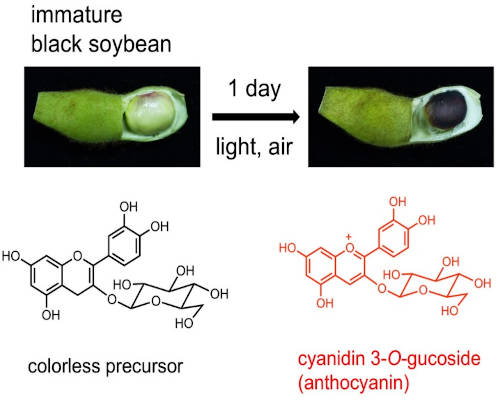
The scientists examined how much Cy3G and 2F3G were present in the black soybean seed coat as it turned colour from green to black once it was exposed to air and light. The immature seed coat contains the colorless precursor, 2F3G, which is oxidized to Cy3G, turning the seed black.
Nagoya University scientists have furthered understanding of how plants make a common pigment that might have medicinal applications. They published their findings in the journal Scientific Reports.
"We studied black soybeans and found a new biosynthetic precursor of the most common anthocyanin in plants," says Kumi Yoshida of Nagoya University, who led the study and specializes in natural products chemistry.
Anthocyanins are plant pigments with anti-oxidant activities. They are responsible for many of the red through purple to blue colors found in flowers, fruits, vegetables and roots. Scientists are currently researching their medicinal potential for treating metabolic diseases like diabetes and obesity. But so far, anthocyanins can only be extracted from plants. Scientists want to be able to synthesize large amounts of the pure compounds to accelerate research into their potential benefits, which requires understanding how plants make them.
The most common anthocyanin is cyanidin-3-O-glucoside (Cy3G). Scientists already know quite a lot about how it is made in plants. However, recent research has cast doubt on part of its biosynthetic pathway. Yoshida and her team investigate how plants synthesize pigments, and set out to clarify how Cy3G is made in black soybeans. Normally, the immature seed is green in its pod. Over the course of two months, it turns black due to the accumulation of Cy3G. Exposing the immature green seed to light and air accelerates this process, causing it to turn black within a day.
Yoshida and a team of scientists from Nagoya University and the National Institute of Health Sciences in Japan took advantage of this rapid transformation and analyzed the molecular contents in the seed before, during and at the end of the color change of exposed seeds. They specifically focused on Cy3G and another compound called tetrahydroxyflav-2-en-3-ol-O-glucoside (2F3G), which was identified by another research team a few years ago.